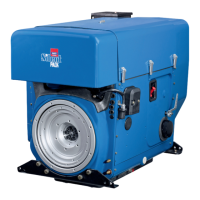Removing dry dirt
Persons handling compressed air must
wear protective goggles.
38
– Clean the cooling fan, cylinder head and cylin-
ders with a suitable brush.
39
Note:
On the encapsulated engine, also clean the area
between the baseplate and the crankcase.
– Blow out the entire cooling area zone with
compressed air.
– Clean the engine oil cooler only by blowing out
with compressed air. In this case, do not direct
a powerful air jet against the easily damaged
cooling fins (Figure 39).
Removing damp or oily dirt
– Disconnect the negative lead at the battery.
– Manually clean alternator and regulator.
– Shield the alternator with attached voltage
regulator; do not spray it directly.
– Clean the complete area with a suitable deter-
gent solution in accordance with its manufac-
turer’s instructions, then spray down with a
powerful water jet.
Do not splash electrical system with water jet
or pressure jet during engine cleaning.
Note:
Do not use petrol (gasoline) or acid cleaning
agents.
– Dry the engine with a compressed air jet.
– Trace the cause of any contamination with oil
and have the leak eliminated by a HATZ service
station.
– Install the capsule or air guide elements
previously removed.
– Run the engine until warm, to prevent residual
moisture from causing rust.
The engine must never be run without
all guards and covers in position.
5.3.3. Checking threaded connections
Check the tightness of all threaded connections
and take up slack if necessary, provided that
these can be reached during maintenance work.
28

